You're using an outdated browser. Please upgrade to a modern browser for the best experience.
Please note this is a comparison between Version 1 by Séverine ROSA LATAPIE and Version 2 by Jason Zhu.
The energy and environmental transition in the building sector requires the development and use of low-impact materials. Despite the growing interest in bio-based and earth-based building materials, their widespread adoption is still limited due to a lack of hindsight, as their study is relatively recent.
- bibliometric
- bio-based building material
- earth-based building material
1. Introduction
The 21st century is the one of global warming awareness. The risks for humanity are major: an increase in natural disasters and their consequences (high mortality, major destruction of buildings and historic sites, etc.), loss of biodiversity, food insecurity, societal conflicts or negative impacts on health (pollution-related pathologies, anxiety, access to drinking water, more pathogens, etc.) [1][2][3][4][1,2,3,4]. As the construction sector is one of the most environmentally impacting [5][6][5,6], research into low-impact building materials has been multiplying in recent years. This especially applies to bio-based and earth-based building materials.
Bio-based materials provide performances that contribute to both energy efficiency and building comfort by incorporating agricultural by-products (hemp shiv, sunflower pith or bark, flax shiv, etc.) or wild plants (reed, bamboo, etc.) [7][8][9][7,8,9]. In the literature, recent reviews of their thermo-hydric performances and applications [10], their fire behaviors [11], the alternative binders used [12], but also the economic and political obstacles to their development [13] are available. No overall analysis has been carried out on this emerging field of research in terms of bibliometric analysis.
Earth-based materials have been used in construction for thousands of years, but their study is relatively new [14]. Their potential is known: low gray energy, low carbon dioxide emissions and recyclability (if not stabilized) [15][16][15,16]. Moreover, the hygroscopic capacity of clay-based material ensures indoor hygrometric equilibrium [17]. However, while this eco-material is being used with innovative techniques such as 3D printing [18], it is still difficult to understand its behavior. This presents difficulties of characterization [19] and reproducibility [20]. Review articles examine the environmental benefits of earth construction [15], the effect of incorporating plant fibers or aggregates [14][21][14,21], or characterization and production techniques [22][23][22,23]. The social, political, and economic aspects of using raw earth in construction have also been studied [24][25][24,25]. However, there is neither a comprehensive study nor a bibliometric analysis of the research carried out to date on this ancestral material.
The choice of treating both bio- and geo-based building materials in the same bibliometric study is a conscious one. These materials share a common history. Although they have only recently been studied, ancestral construction techniques demonstrate the relevance of using plant fibers in earth-based matrices [26][27][28][26,27,28]. This is due to the complementary nature of the two materials. Earth is a structural material that passively regulates ambient humidity, thus contributing to the building’s interior comfort [22]. Plant-based aggregates also have the ability to moderate humidity variations in the indoor environment, and no deleterious effects are observed when plant aggregates are incorporated into a clay base, contrary to observations made for certain combinations of aggregates and cementitious matrices [9]. Consequently, the combined effects of the two materials offer great passive humidity regulation capacities [29]. In addition, incorporating plant aggregates can improve the thermal performance of an earth material [30][31][32][30,31,32] and limit its drying shrinkage [33]. A growing number of research projects are exploiting this potential by combining the use of plant-based aggregates and raw earth [34][35][36][34,35,36].
2. Preliminary Statistical Analysis
2.1. Bio-Based Building Materials
-
Increasing number of scientific publications
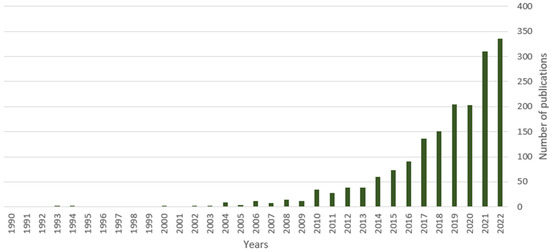
Figure 12.
Number of publications concerning bio-based materials between 1990 and 2022 according to Web of Science.

Figure 23.
Typology of publications on bio-based building materials between 1990 and 2022 according to Web of Science data.
-
Geographic and editorial dynamics
-
Main topics covered
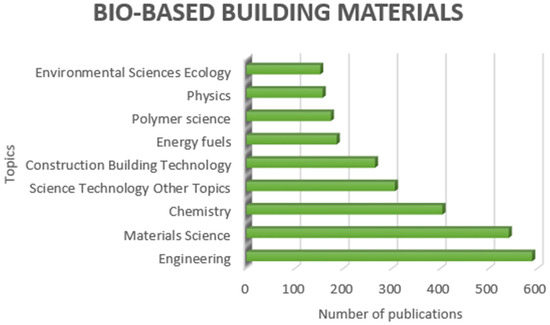
Figure 34.
Main topics studied in publications concerning bio-based building materials between 1990 and 2022 according to Web of Science data.
-
Focus on raw materials
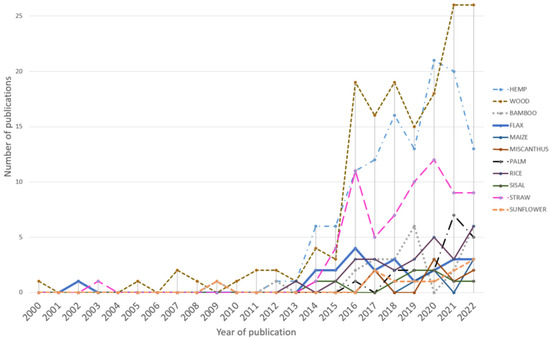
Figure 45.
Number of publications for the main raw materials identified in bio-based building materials over the years.
2.2. Earth-Based Building Materials
-
Increasing number of scientific publications
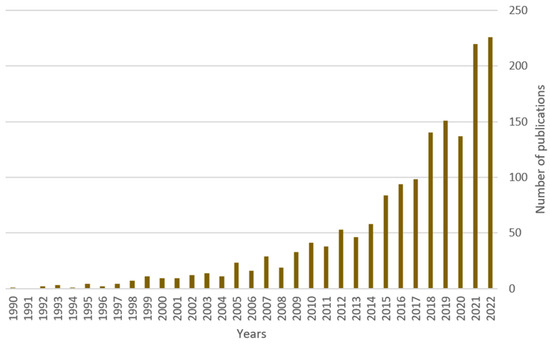
Figure 56.
Number of publications concerning earth-based materials between 1990 and 2022, according to Web of Science data.
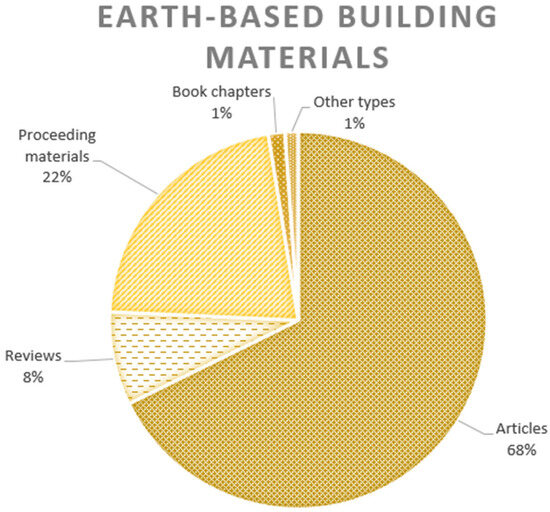
Figure 67.
Typology of publications on geo-based building materials between 1990 and 2022 according to Web of Science data.
-
Geographic and editorial dynamics
-
Main topics covered
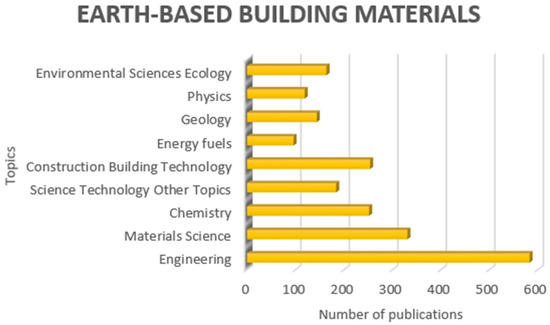
Figure 78.
Main topics studied in publications concerning earth-based materials between 1990 and 2022 according to Web of Science data.
-
Focus on implementation techniques
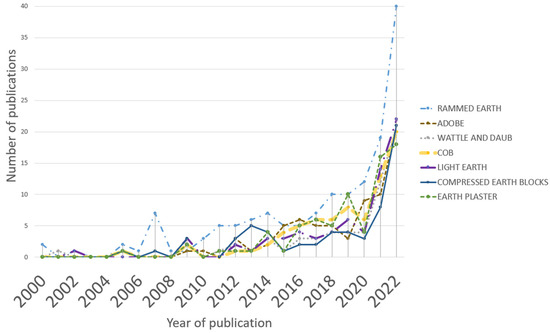
Figure 89.
Number of publications for the main implementation techniques of geo-based building materials over the years.
3. Comparative Study with Composite Building Materials
3.1. Evolution in the Number of Publications on Composite Materials
It seemed interesting to compare the evolutionary dynamics of bio- and geo-sourced materials with a research field that emerged a few decades earlier, in the 1960s—composite materials. To take a global view and appreciate the research dynamics in these materials, the statistical study was not limited to composite materials used in construction. All sectors have been considered here (Figure 910).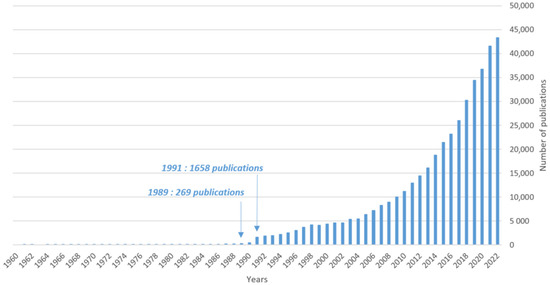
Figure 910.
Number of publications concerning composite materials between 1960 and 2022 according to Web of Science data.
-
Obviously, the number of publications is extremely high, providing an overall perspective. What is striking is the number of publications, which increased more than six-fold between 1989 and 1991. It is legitimate to question the reasons for this major breakthrough in composite materials and related work in those years.
-
The 1990s marked the beginning of the computer age. Since then, computer networks have been driving progress in science and engineering [71][83]. One possible explanation for the inflection point in publication growth is the development of computer technology. Before the 2000s, numerous publications incorporating computerized tools were noticed [72][73][74][75][84,85,86,87].
3.2. Emerging Themes and Tools for New Developments
In order to assess the above hypothesis, the evolution of the number of publications related to composite materials dealing with modeling, which requires the use of computer tools, was observed around the year 2000 (Figure 11).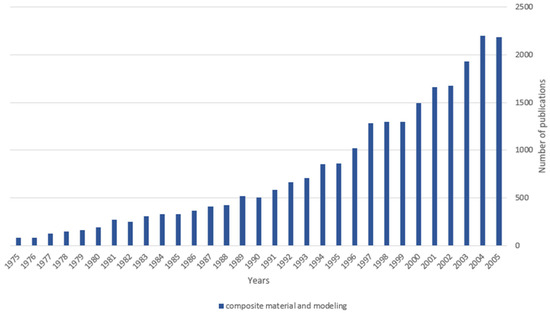
Figure 11.
Number of publications concerning modeling and composite materials in the 2000s according to Web of Science data.
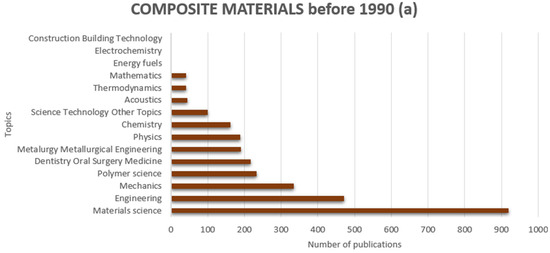
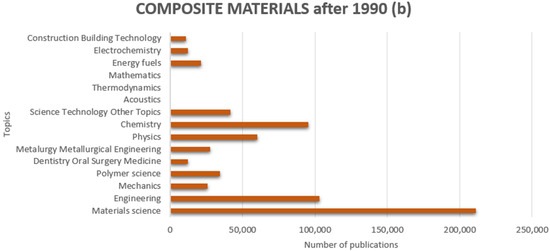
Figure 12. Main research areas studied in the field of composite materials from 1960 to 1990 (a) and from 1990 to 2022 (b) according to Web of Science data.
3.3. Eco-Materials: What about Modeling and the Hard Sciences?
The subject of modeling in bio- and geo-based building materials seems to be in its infancy, as indicated by the number of publications over the years (Figure 13).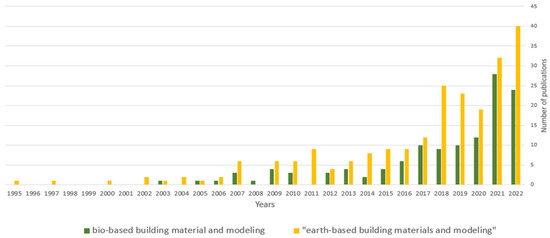
Figure 13.
Number of publications concerning modeling and bio-based or geo-based building materials according to Web of Science data.
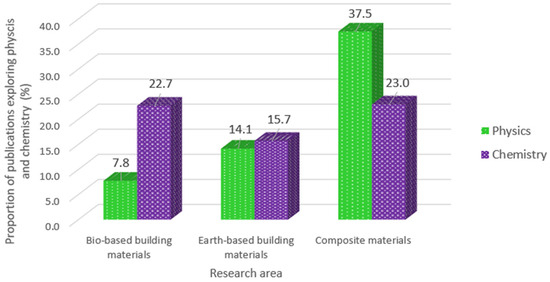
Figure 14.
Proportion of publications, from 1900 to 2022, dealing with physics or chemistry in different types of materials according to Web of Science data.
4. Bibliometric Networks
4.1. Bio-Based Building Materials
-
Main authors and their collaborations
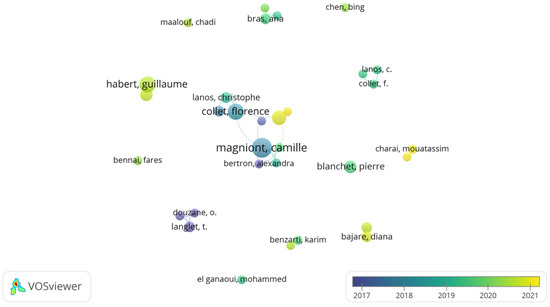
Figure 15. Co-authorship networks of authors (with minimum of five publications) concerning bio-based building materials, with time scale over the last few years.
-
Founding works
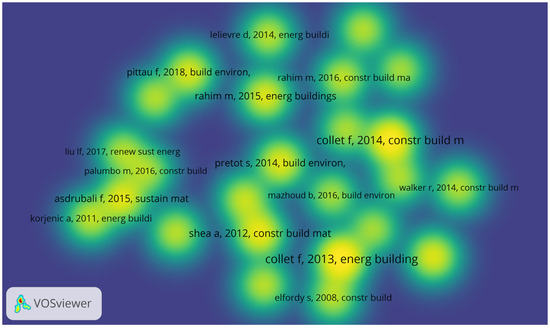
-
Key themes in the literature
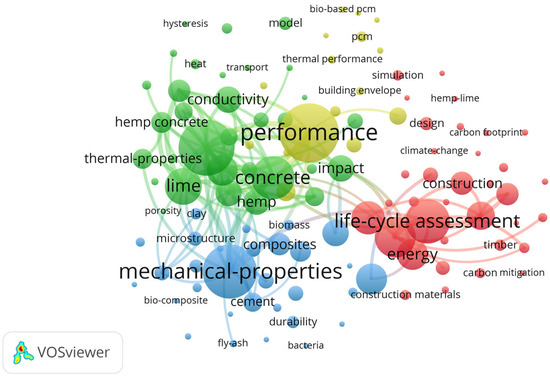
Figure 17.
Co-occurrence networks of keywords concerning bio-based building materials.
-
Focus on main raw materials
-
In order to provide a closer insight into the contributions made to date on the main raw materials identified in Section 3.1.1, an analysis of keyword co-occurrence was carried out within the relevant publications. The visualization includes a time scale to emphasize trends over recent years. For the sake of relevance, this section focuses exclusively on primary resources with more than 10 publications each: hemp, wood, bamboo, flax, palm, rice, straw, sunflower (Figure 18)Section 3.1.1, an analysis of keyword co-occurrence was carried out within the relevant publications. The visualization includes a time scale to emphasize trends over recent years. For the sake of relevance, this section focuses exclusively on primary resources with more than 10 publications each: hemp, wood, bamboo, flax, palm, rice, straw, sunflower (Figure 18).
- -
-
“Cellulose”: linked to the chemical composition of the resource, particularly relevant to wood as a primary chemical compound.
- -
-
“Moisture content”: in relation to water adsorption by the material and potential pathologies arising under such conditions.
- -
-
“Sustainability“: referring to the evolution of a material’s properties under various stresses, including temperature and relative humidity variations over its lifetime.
- -
-
“Energy”: related to the overall energy efficiency of the building, i.e., covering a more global scale than that of the material or the wall.
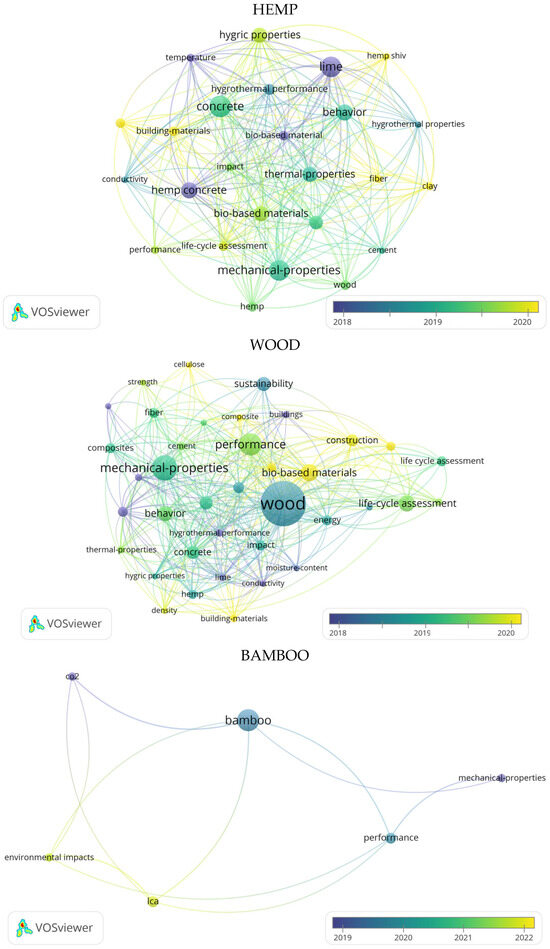
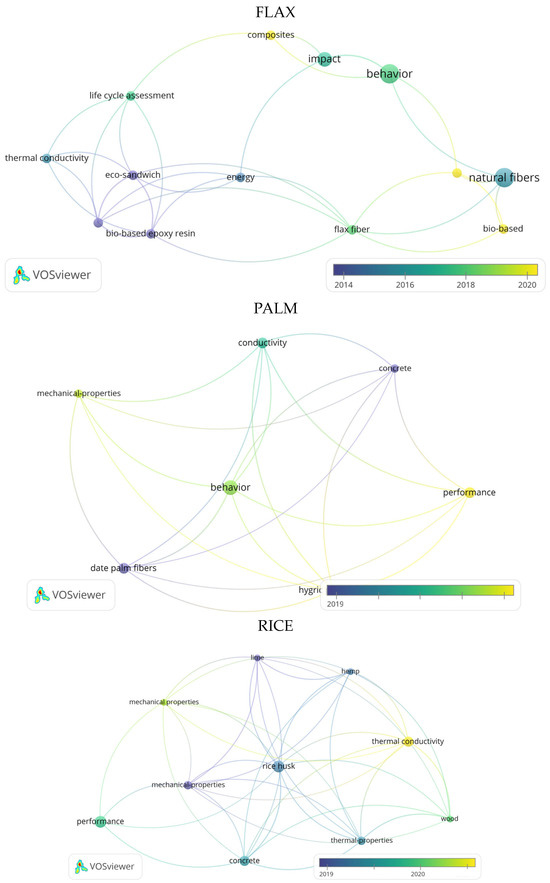
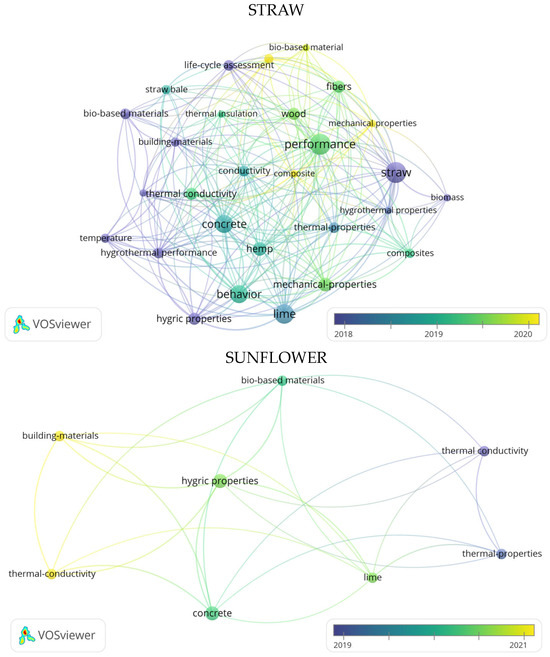 Figure 18.Co-occurrence networks of keywords concerning publications about the most widely studied implementation techniques in the literature.
Figure 18.Co-occurrence networks of keywords concerning publications about the most widely studied implementation techniques in the literature.4.2. Geo-Based Building Materials
- Main authors and their collaborations
According to this map, collaboration between authors appears even more limited than that for bio-based building materials. The few collaborations that are visualized mostly involve authors from the same affiliation. The time scale shows that the number of collaborations have been multiplying very recently. No significant European or international collaborations are to be reported, since they involve authors from the same country and often from the same affiliation.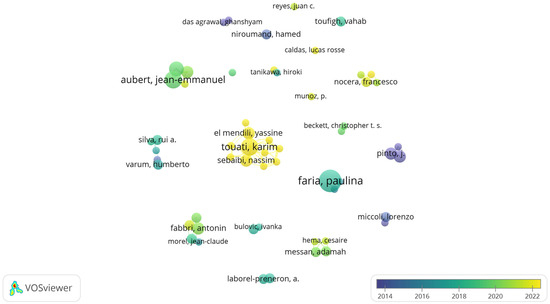 Figure 19. Co-authorship networks of authors (with minimum of three publications) concerning geo-based building materials, with time scale over the last few years.
Figure 19. Co-authorship networks of authors (with minimum of three publications) concerning geo-based building materials, with time scale over the last few years.- Founding works
- The most frequently cited research works date from the 1990s to 2000s (
- Figure 20
- ). These works are considered foundational in the field.
Similarly to bio-based materials, this list of works can help identify fundamental results in the field of raw earth building materials research.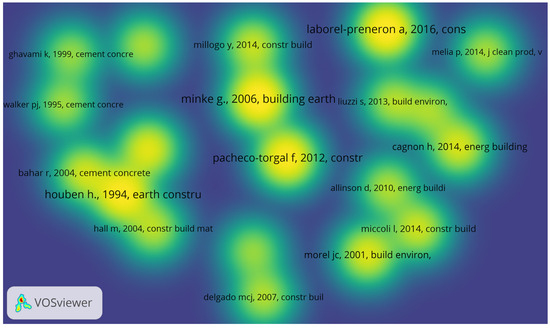
- Co-authorship links
The keywords mainly associated with the research work do not highlight strong themes related to the hard sciences. It is reasonable to conclude that physics in particular is a little-explored field. Moreover, modeling, which is identified in the “environmental impact” cluster, is clearly very little covered.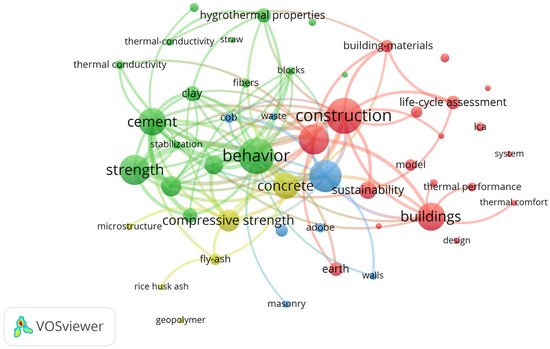 Figure 21.Co-occurrence networks of keywords concerning geo-based building materials.
Figure 21.Co-occurrence networks of keywords concerning geo-based building materials.- Focus on implementation techniques
- In order to provide a closer insight into the contributions concerning implementation in
- Section 3.1, an analysis of keyword co-occurrence was carried out on the publications relating to them. The time scale is added to the visualizations to underline the trend over the last few years. All techniques are included, as they have been studied in over 10 publications (
- Figure 22
- )
- , an analysis of keyword co-occurrence was carried out on the publications relating to them. The time scale is added to the visualizations to underline the trend over the last few years
- .
- All techniques are included, as they have been studied in over 10 publications (
- Figure 22
- ).
- -
-
Variability of the raw resource [106][107][118,119]: raw earth is a mixture of clay, silt, sand, gravel and pebbles of varying natures and proportions, depending on where it was extracted [108][120].
- -
-
Pre-conceived ideas: earth can suffer from a bad image for economic, political and social reasons [24][51][24,60]
- -
-
Traditional craftsmanship: as earth is a material used for millennia, the implementation techniques are often the result of real know-how sometimes difficult to reconcile with current techniques and constraints [51][109][60,121].
- -
-
Life cycle assessment: as earth is a low-embodied carbon construction material [24], life cycle assessment methodology may adequately demonstrate its potential in place of conventional materials.
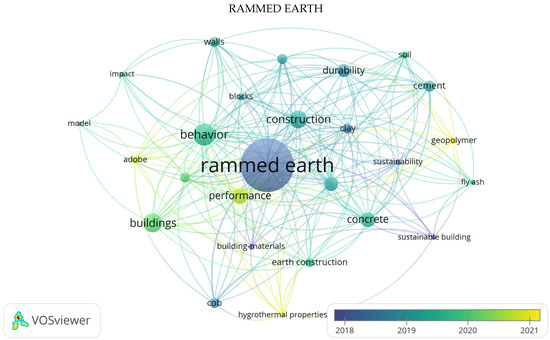

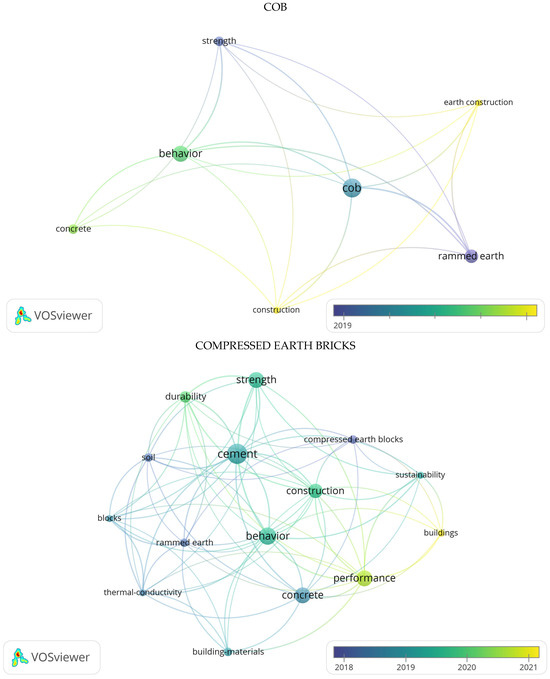
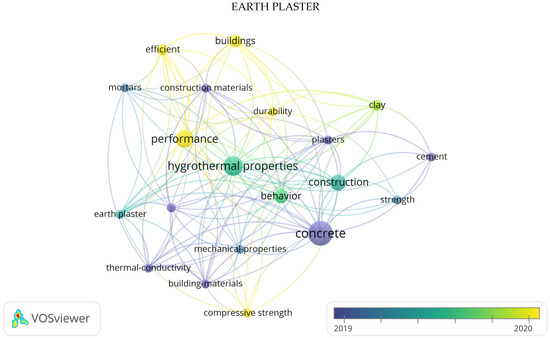 Figure 22.Co-occurrence networks of keywords concerning publications about the most widely studied raw materials in the literature.
Figure 22.Co-occurrence networks of keywords concerning publications about the most widely studied raw materials in the literature.4.3. Potential Emerging Themes
The visualization maps in the sections focusing on bio- and geo-based building materials enable one to appreciate the most frequently addressed themes and, consequently, those that are less explored. To further enhance the analysis, a co-occurrence map of key words corresponding to articles on composite building materials in 2022 has been generated. By comparison, this allows the detection of different themes that could potentially contribute to the development of eco-materials (Figure 23).Logically, topics similar to eco-materials can be found, such as mechanical behavior and performance. Performance is linked in an interesting way to optimization, which was not identified in the case of bio- and geo-based building materials. This suggests it as a first avenue of study. In the context of composite building materials, it is worth noting that the study of behavior is linked to modeling with the notion of machine learning. This link was not represented in previous maps, making it another avenue of exploration.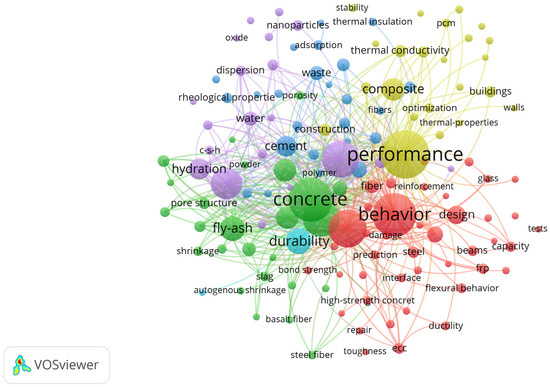 Figure 23.Co-occurrence networks of keywords concerning composite building materials (2022).
Figure 23.Co-occurrence networks of keywords concerning composite building materials (2022).
